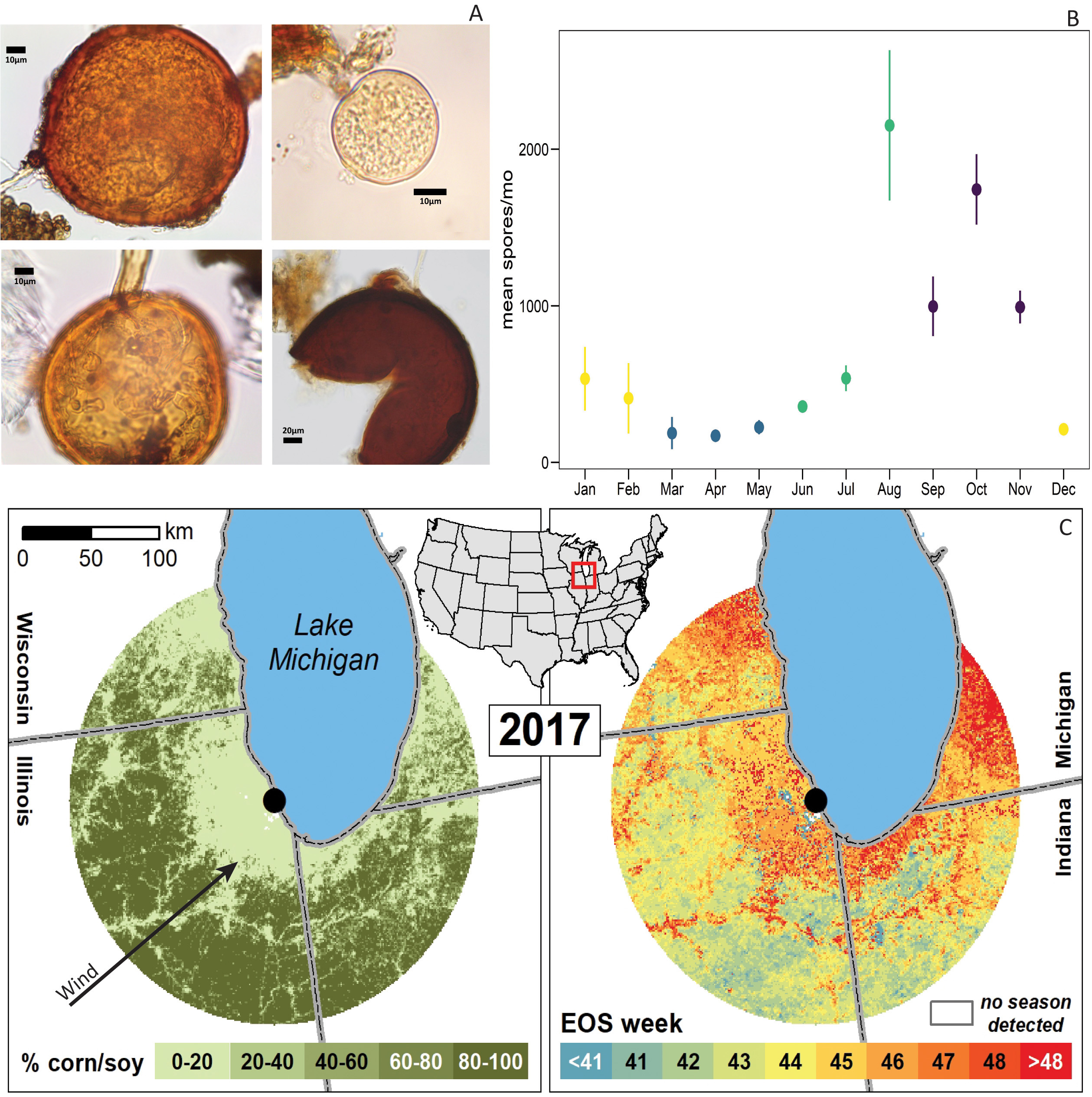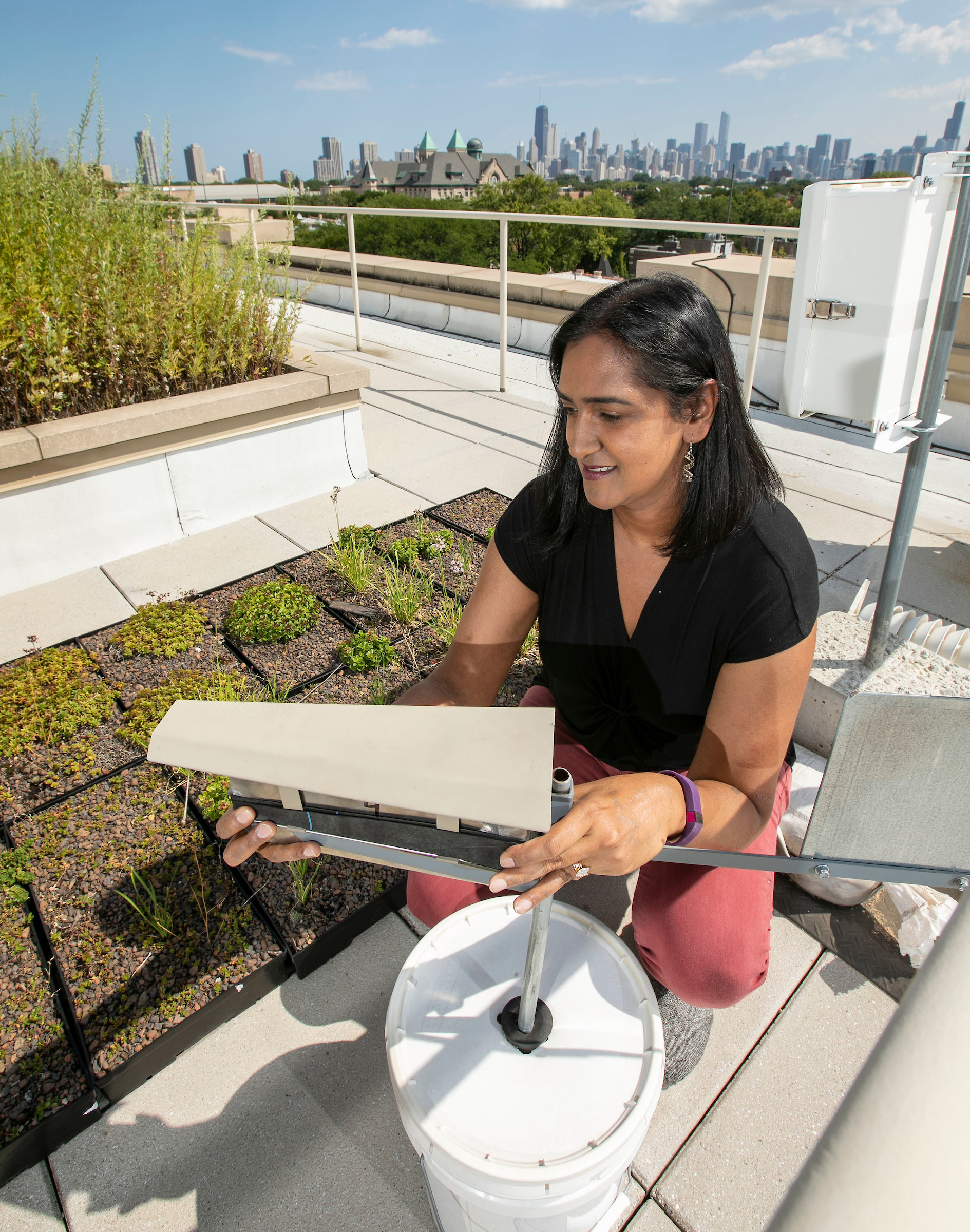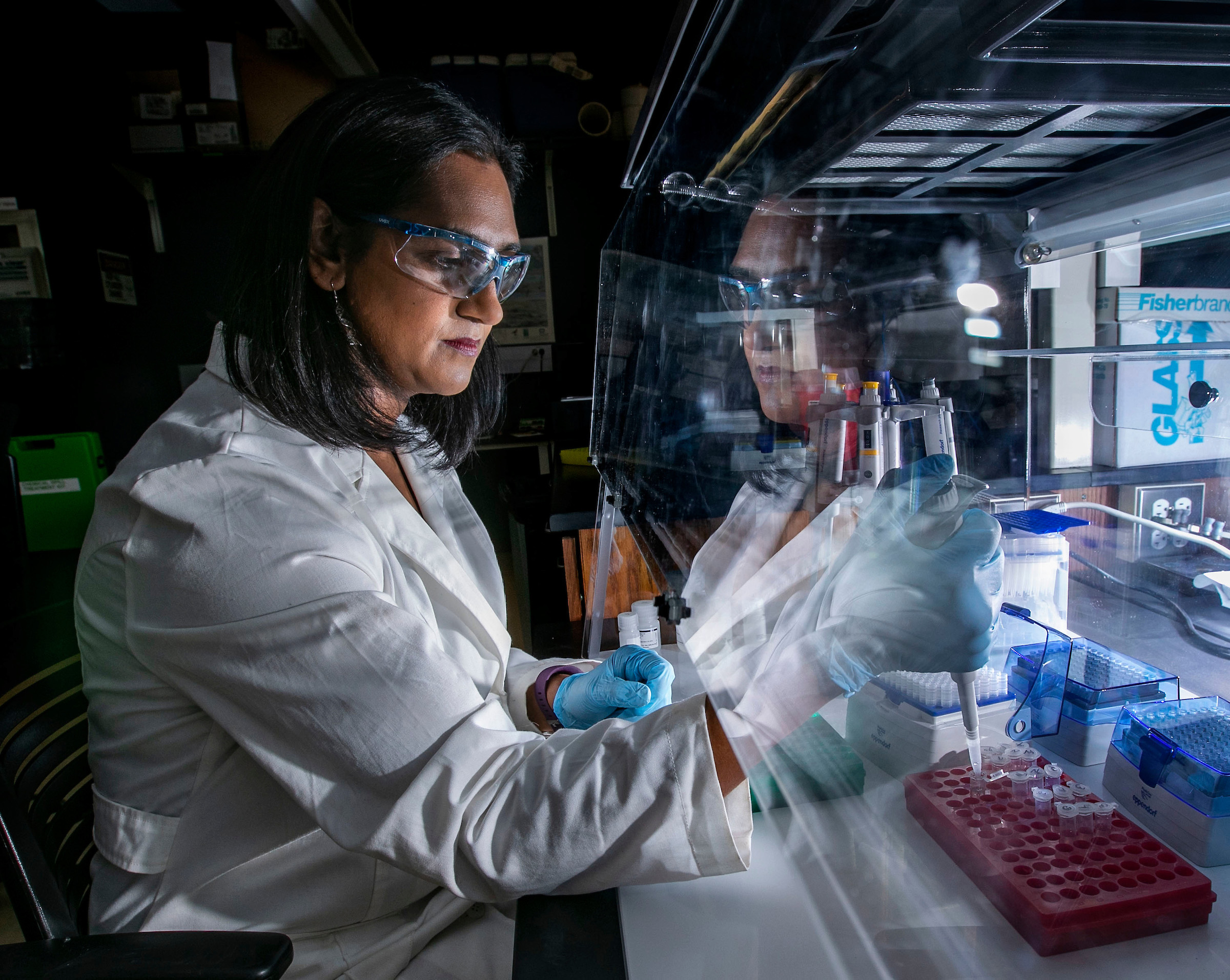 Figure 2 from article “Trait‐based aerial dispersal of arbuscular mycorrhizal fungi,” published in the journal New Phytologist. (A) Commonly encountered aerial arbuscular mycorrhizal fungal spores (clockwise from top left Claroideoglomus etunicatum, Archaeospora trappei, Septoglomus constrictum, and Glomus microcarpum), and (B) monthly mean ± standard error for spore abundance categorized by seasons (yellow = winter, blue = spring, green = summer, purple = fall). Lower-left panel in (C)shows corn or soy cover per 1 km2 pixel developed using the USDA National Agricultural Statistics Service 2017 Cropland Data Layer, while the lower-right panel illustrates the week during 2017 when dominant vegetation completed senescence (i.e. reached end-of-season, or EOS) for a 150 km buffer around study site. (Study co-authors Bala Chaudhary and Jude Kastens)CHICAGO — Microbes are everywhere. Some cause disease, but many form helpful symbioses and make up microbiomes necessary for promoting good health. Most plants on Earth in fact form beneficial symbioses with invisible belowground microbes called mycorrhizal fungi that can have large implications for agriculture, forestry and ecosystems.
Figure 2 from article “Trait‐based aerial dispersal of arbuscular mycorrhizal fungi,” published in the journal New Phytologist. (A) Commonly encountered aerial arbuscular mycorrhizal fungal spores (clockwise from top left Claroideoglomus etunicatum, Archaeospora trappei, Septoglomus constrictum, and Glomus microcarpum), and (B) monthly mean ± standard error for spore abundance categorized by seasons (yellow = winter, blue = spring, green = summer, purple = fall). Lower-left panel in (C)shows corn or soy cover per 1 km2 pixel developed using the USDA National Agricultural Statistics Service 2017 Cropland Data Layer, while the lower-right panel illustrates the week during 2017 when dominant vegetation completed senescence (i.e. reached end-of-season, or EOS) for a 150 km buffer around study site. (Study co-authors Bala Chaudhary and Jude Kastens)CHICAGO — Microbes are everywhere. Some cause disease, but many form helpful symbioses and make up microbiomes necessary for promoting good health. Most plants on Earth in fact form beneficial symbioses with invisible belowground microbes called mycorrhizal fungi that can have large implications for agriculture, forestry and ecosystems.
A new study published in the journal New Phytologist from a research team led by environmental scientist Bala Chaudhary at DePaul University uncovered previously undiscovered patterns in the dispersal of mycorrhizal fungi that could help ecologists understand how these beneficial fungi travel.
 Assistant Professor Bala Chaudhary collects dust for mycorrhizal fungal analyses on the roof high atop the McGowan South building on the DePaul University Lincoln Park Campus in Chicago. (DePaul University/Jamie Moncrief)
Assistant Professor Bala Chaudhary collects dust for mycorrhizal fungal analyses on the roof high atop the McGowan South building on the DePaul University Lincoln Park Campus in Chicago. (DePaul University/Jamie Moncrief)Researchers collected dust in aerial samplers on a five-story high Chicago rooftop for 12 consecutive months in 2017 and used DNA-barcoding to identify which mycorrhizal fungal species were more common at different times during the year. More than 47,000 arbuscular mycorrhizal fungal spores were captured and were present during every month of the year, including winter.
Chaudhary and colleagues found a diversity of mycorrhizal fungal species in the aerial samples, in particular species that are more common in agricultural soils. This finding, coupled with the timing of when spores peak in the air, indicated that anthropogenic soil disturbance like tillage could be liberating fungal spores from belowground to facilitate long distance wind dispersal.
Mycorrhizal fungi are among the most common beneficial fungi, mining soil nutrients and delivering them to plants in exchange for sugars, explained Chaudhary. However, the impact they have on plants depends on the type of fungal species present. Environmental factors and dispersal determine microbial community structure, but little is known about how microbes disperse long distances.
“It all started when we found in a previous study that mycorrhizal fungi were building up in urban green roof soils over time. Since these fungi exist entirely belowground, don’t make mushrooms, and form some of the largest fungal spores on Earth, they are not thought to be dispersed very well by wind. So how were they getting onto skyscrapers in the middle of Chicago?” Chaudhary said.
“The answer in my mind is ‘the wind.’ This most recent study shows that wind is a much more common vector of movement of mycorrhizal fungi than we previously thought,” she said.
Because mycorrhizal fungi can improve plant growth, they have a natural application in agriculture, as biofertilizers and products containing mycorrhizal fungi are available for purchase in most garden stores. But Chaudhary warned that most commercial products don’t contain local native mycorrhizal fungal species or species that will necessarily promote plant health. Understanding which mycorrhizal fungal species can disperse on their own and don’t need to be restored to soils with commercial products could save consumers a lot of money, she said.
 Assistant Professor Bala Chaudhary extracts DNA from dust for targeted mycorrhizal fungal DNA-barcoding analyses in her mycorrhizal ecology Lab at DePaul University. (DePaul University/Jamie Moncrief)
Assistant Professor Bala Chaudhary extracts DNA from dust for targeted mycorrhizal fungal DNA-barcoding analyses in her mycorrhizal ecology Lab at DePaul University. (DePaul University/Jamie Moncrief)“We can’t really talk about how pervasive this phenomenon is in the world unless we expand the research to include more locations,” Chaudhary said. She has funding to collect spores in 20 different sites across the United States, including Alaska, Hawaii and Puerto Rico.
“In those areas, we’ll set up dust collectors, trap spores, measure their traits, do their DNA-barcoding and then see just how prevalent aerial dispersal is at large spatial scales,” she said.
Co-authors of the study include Sarah Nolimal, who was a DePaul University undergraduate environmental science major at the time; Cameron Egan of Okanagan College, Canada; Jude Kastens of the University of Kansas; and Moisés A. Sosa‐Hernández of Freie Universität in Berlin.
This study is based upon work supported by a National Science Foundation CAREER award (DEB-1844531) to Chaudhary.
###
Source:
Bala Chaudhary
Media Contact:
Carol Hughes
312-608-2206 cell